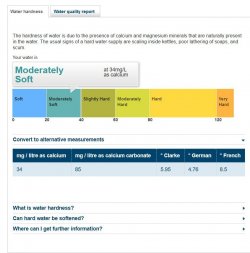We always say to look on your water provider's website for hardness, and to ignore any words, look for a number.
These are UK water company definitions of hardness compared to what we consider to be hard, soft and middling in fish keeping.
Always look for numbers
These are UK water company definitions of hardness compared to what we consider to be hard, soft and middling in fish keeping.
Always look for numbers
| dH | ppm | Water company | Fish keeping |
| 0 – 2.8 | 0 - 50 | soft | very soft |
| 2.8 – 5.6 | 50 - 100 | moderately soft | soft |
| 5.6 – 8.4 | 100 - 150 | slightly hard | soft |
| 8.4 – 11.2 | 150 - 200 | moderately hard | soft to middling |
| 11.2 – 16.8 | 200 - 300 | hard | middling to hard |
| over 16.8 | over 300 | very hard | hard to very hard |




